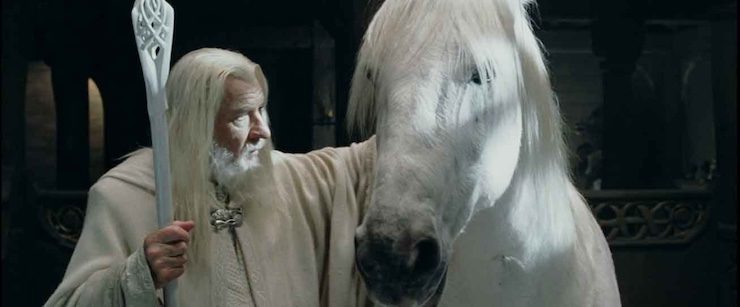Hello, people of Tor.com! Some of you know me from my rereads of two mothers of modern fantasy, Melanie Rawn and Katherine Kurtz. I’m moving on now to a biweekly (or semiweekly) column on a subject that preoccupies me every day here on the farm: Horses!
From the time my grandfather sat me on a friend’s horse at six months old, I’ve been one with the tribe of horse people. I started riding in grade school, started high school with my first horse. I rode through college and grad school (and studied the horse in history, and of course wrote them into my fiction), then when I fled to the Arizona desert in search of peace, quiet, and low humidity, one horse led to two, then three, then a small breeding farm. When the economy collapsed, the breeding operation shut down, but the stallion and his mares for the most part stayed. They’re still very much a part of my life, and they’re my toughest critics when it comes to understanding the species.
For quite a few years I wrote the Horseblog at Book View Cafe, an ongoing discussion, reminiscence, and educational ramble around the history, lore, and science of the horse. I collected some of these essays into a short but useful ebook for writers, Writing Horses: The Fine Art of Getting It Right, but there’s much, much more where that came from.
I’ll talk about some of these topics here, but with a more distinctly sffnal slant—hence, “The SFF Equine.” That’s everything from how to write believable horses (and writers who do it right), to horses in film (and the actors who ride them, and the mistakes that perpetuate from film to film), to horses in fantasy and science fiction (yes: Ponies in Space!), and horses in gaming. Pretty much anything in genre that addresses or includes the equines, I’ll be there.
I take questions. If you have a question or a suggestion or an idea for a column, by all means post in the comments. I’m here to entertain and inform, and to share my enthusiasm for the subject.
What we have here is one of a few animal species that has lived in symbiosis with humans for millennia, and has been genetically modified to accommodate human needs and aesthetics. The history of war in many parts of the world is the history of the horse. So is the history of transportation, up until the age of mechanical transport.
The horse is unique in both its physical structure, which adapts well to pulling a vehicle and carrying one or more humans, and its psychology, which makes it particularly amenable to domestication. A horse even in its original, unmodified form is large and sturdy enough to be ridden (consider the Mongol horse, which is quite a bit on the small side by modern standards, but easily and consistently carries adult humans), and its speed and stamina make it possible for humans to travel long distances in a relatively short time. The ramifications of this for migration and war are significant.
None of that would have worked however if horses had not been innately cooperative. As prey animals they have a highly developed flight instinct, but they’re also herd animals, with a complex social structure and a clear but fluid hierarchy that adapts well to human intervention. The human trainer can overcome the reactivity and the impulse to hit warp thrusters at the first hint of a threat, by taking advantage of the cooperative instinct and the tendency to stay together with the herd.
The relationship can be strictly utilitarian—horse as transport or sports equipment—but many horse cultures have tended toward a kind of symbiosis of horse and human. The divine horse, the centaur, the horse warrior who evolved into the knight, all create and perpetuate a sense of the horse as something more than a domestic animal. The horse becomes a magical being; and so we come to Tolkien’s Shadowfax, Mercedes Lackey’s Companions, and ultimately, Anne McCaffrey’s dragons.
Our genre, especially the fantasy part of it, runs on horsepower. As much as the internet is made of cats, and the dog is man’s best friend, the horse is the dominant transport of countless fantasy worlds. Western writers particularly have difficulty imagining a preindustrial culture without the horse, it’s so prevalent in the underpinnings of their history and society.
This is true even while we’ve moved conclusively away from horse transport and cavalry warfare. Writers and readers who have had little or no physical contact with a horse still gravitate toward worlds in which the horse is an essential component. The mythos endures even while the reality slips into the past.
Not that the horse shows any sign of disappearing from the human world. Horses still serve as transport on at least six continents, and racing and various forms of recreation feed a substantial industry. (And horses literally feed humans and their carnivorous pets in various parts of the world as well.) Horses are large, expensive, and require acres of land to thrive, but people persist in making it happen. When we finally move en masse into space, I think we’ll find ways then, too, and reasons to preserve that particular form of interspecies cooperation.
Judith Tarr is a lifelong horse person. She supports her habit by writing works of fantasy and science fiction as well as historical novels, many of which have been published as ebooks by Book View Cafe. Her most recent short novel, Dragons in the Earth, features a herd of magical horses, and her space opera, Forgotten Suns, features both terrestrial horses and an alien horselike species (and space whales!). She lives near Tucson, Arizona with a herd of Lipizzans, a clowder of cats, and a blue-eyed spirit dog.










